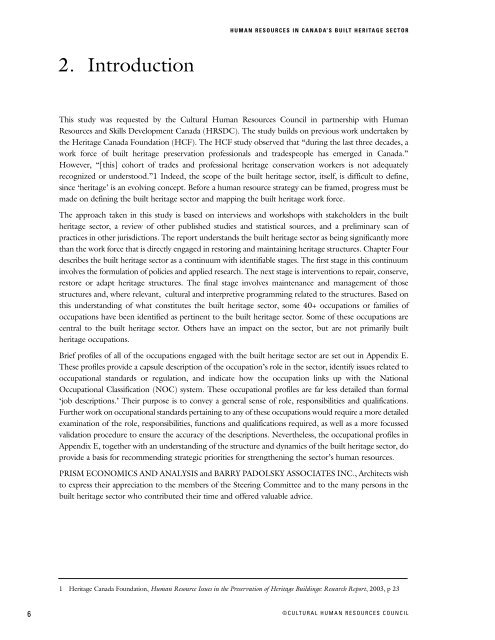Human Resources in Canada's Built Heritage Sector: Mapping the ...
Human Resources in Canada's Built Heritage Sector: Mapping the ...
Human Resources in Canada's Built Heritage Sector: Mapping the ...
- No tags were found...
Create successful ePaper yourself
Turn your PDF publications into a flip-book with our unique Google optimized e-Paper software.
HUMAN RESOURCES IN CANADA’S BUILT HERITAGE SECTOR2. IntroductionThis study was requested by <strong>the</strong> Cultural <strong>Human</strong> <strong>Resources</strong> Council <strong>in</strong> partnership with <strong>Human</strong><strong>Resources</strong> and Skills Development Canada (HRSDC). The study builds on previous work undertaken by<strong>the</strong> <strong>Heritage</strong> Canada Foundation (HCF). The HCF study observed that “dur<strong>in</strong>g <strong>the</strong> last three decades, awork force of built heritage preservation professionals and tradespeople has emerged <strong>in</strong> Canada.”However, “[this] cohort of trades and professional heritage conservation workers is not adequatelyrecognized or understood.”1 Indeed, <strong>the</strong> scope of <strong>the</strong> built heritage sector, itself, is difficult to def<strong>in</strong>e,s<strong>in</strong>ce ‘heritage’ is an evolv<strong>in</strong>g concept. Before a human resource strategy can be framed, progress must bemade on def<strong>in</strong><strong>in</strong>g <strong>the</strong> built heritage sector and mapp<strong>in</strong>g <strong>the</strong> built heritage work force.The approach taken <strong>in</strong> this study is based on <strong>in</strong>terviews and workshops with stakeholders <strong>in</strong> <strong>the</strong> buil<strong>the</strong>ritage sector, a review of o<strong>the</strong>r published studies and statistical sources, and a prelim<strong>in</strong>ary scan ofpractices <strong>in</strong> o<strong>the</strong>r jurisdictions. The report understands <strong>the</strong> built heritage sector as be<strong>in</strong>g significantly morethan <strong>the</strong> work force that is directly engaged <strong>in</strong> restor<strong>in</strong>g and ma<strong>in</strong>ta<strong>in</strong><strong>in</strong>g heritage structures. Chapter Fourdescribes <strong>the</strong> built heritage sector as a cont<strong>in</strong>uum with identifiable stages. The first stage <strong>in</strong> this cont<strong>in</strong>uum<strong>in</strong>volves <strong>the</strong> formulation of policies and applied research. The next stage is <strong>in</strong>terventions to repair, conserve,restore or adapt heritage structures. The f<strong>in</strong>al stage <strong>in</strong>volves ma<strong>in</strong>tenance and management of thosestructures and, where relevant, cultural and <strong>in</strong>terpretive programm<strong>in</strong>g related to <strong>the</strong> structures. Based onthis understand<strong>in</strong>g of what constitutes <strong>the</strong> built heritage sector, some 40+ occupations or families ofoccupations have been identified as pert<strong>in</strong>ent to <strong>the</strong> built heritage sector. Some of <strong>the</strong>se occupations arecentral to <strong>the</strong> built heritage sector. O<strong>the</strong>rs have an impact on <strong>the</strong> sector, but are not primarily buil<strong>the</strong>ritage occupations.Brief profiles of all of <strong>the</strong> occupations engaged with <strong>the</strong> built heritage sector are set out <strong>in</strong> Appendix E.These profiles provide a capsule description of <strong>the</strong> occupation’s role <strong>in</strong> <strong>the</strong> sector, identify issues related tooccupational standards or regulation, and <strong>in</strong>dicate how <strong>the</strong> occupation l<strong>in</strong>ks up with <strong>the</strong> NationalOccupational Classification (NOC) system. These occupational profiles are far less detailed than formal‘job descriptions.’ Their purpose is to convey a general sense of role, responsibilities and qualifications.Fur<strong>the</strong>r work on occupational standards perta<strong>in</strong><strong>in</strong>g to any of <strong>the</strong>se occupations would require a more detailedexam<strong>in</strong>ation of <strong>the</strong> role, responsibilities, functions and qualifications required, as well as a more focussedvalidation procedure to ensure <strong>the</strong> accuracy of <strong>the</strong> descriptions. Never<strong>the</strong>less, <strong>the</strong> occupational profiles <strong>in</strong>Appendix E, toge<strong>the</strong>r with an understand<strong>in</strong>g of <strong>the</strong> structure and dynamics of <strong>the</strong> built heritage sector, doprovide a basis for recommend<strong>in</strong>g strategic priorities for streng<strong>the</strong>n<strong>in</strong>g <strong>the</strong> sector’s human resources.PRISM ECONOMICS AND ANALYSIS and BARRY PADOLSKY ASSOCIATES INC., Architects wishto express <strong>the</strong>ir appreciation to <strong>the</strong> members of <strong>the</strong> Steer<strong>in</strong>g Committee and to <strong>the</strong> many persons <strong>in</strong> <strong>the</strong>built heritage sector who contributed <strong>the</strong>ir time and offered valuable advice.1 <strong>Heritage</strong> Canada Foundation, <strong>Human</strong> Resource Issues <strong>in</strong> <strong>the</strong> Preservation of <strong>Heritage</strong> Build<strong>in</strong>gs: Research Report, 2003, p 236©CULTURAL HUMAN RESOURCES COUNCIL










